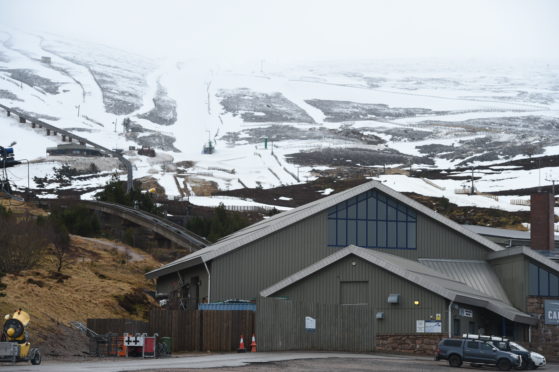
Scotland’s public spending watchdog has raised “serious questions” about the sustainability of the Cairngorm Mountain snow centre in a new report.
Highlands and Islands Enterprise (HIE) stepped in to save the resort for the second time when its operator went into administration in November 2018.
Now Audit Scotland has recommended the enterprise agency “consider fully the options available before deciding on a new operating model for Cairngorm Mountain”.
In a report detailing the problems faced by the resort – which is the largest of five snow centres in Scotland – Audit Scotland said the closure of the funicular railway in September 2018 was the “main catalyst” for operator Cairngorm Mountain Limited (CML) entering administration.
The funicular railway was installed in 2001 as part of efforts to regenerate Aviemore.
It could cost between £10 million and £15 milion to reinstate this – but removing it is also estimated to cost some £13.3 million.
HIE has set up a new subsidiary, Cairngorm Mountain (Scotland) Limited (CMSL), to take over the operation of the resort.
Audit Scotland said it has “made progress in addressing some of the issues that arose under CML” but noted the new body generated an income of £243,000 between Decmeber 2018 and the end of March 2019, against expenditure of £804,000, leaving it with a deficit of £561,000.
The report says: “HIE must also reflect on the issues that have affected Cairngorm Mountain in the past and learn from them to develop a financially sustainable model.
“HIE has had to step in to take over operations at Cairngorm Mountain twice in the space of 10 years.
“This raises serious questions about the sustainability of the business operating under the current model.”
The report adds: “It is a business that is very reliant on weather conditions and any operator is likely to face unpredictable levels of turnover.
“With Cairngorm Mountain operating in already challenging circumstances, it is even more important that good management and decision-making structures are in place to avoid creating additional difficulties.”
The spending watchdog recommended ministers work with HIE to “identify what financial support will be needed for Cairngorm Mountain and how this cost will be met”.
It also called on the Scottish Government to “examine the long-term sustainability of the snow sports industry in Scotland and consider any future financial support in the light of its wider economic priorities”.
Auditor general for Scotland Caroline Gardner said: “HIE and the Scottish Government now face tough decisions on how to secure a sustainable operation at Cairngorm Mountain.
“The Covid-19 pandemic increases the uncertainty around the costs and business model required for the mountain in the longer-term.
“Any future spending decisions need to be informed by the wide range of groups with an interest in the mountain.
“And it’s important they should take into account the resort’s social and environmental impact alongside its economic benefits.”
Anas Sarwar, the acting convener of Holyrood’s Public Audit Committee, said: “The auditor general’s report makes it clear that developing a long-term sustainable model for financing the Cairngorm Mountain is vital.
“Covid-19 of course adds to that uncertainty.
“The committee will no doubt want to explore with the Auditor General the lessons that can be learned from this experience and how these should inform the next steps.”
Cabinet Secretary for Rural Economy and Tourism Fergus Ewing welcomed the report, adding that the Scottish Government is “pleased that Audit Scotland has recognised the significant effort that HIE has gone to, and will continue to take forward”.
He added: “The recommendations from an internal review carried out in 2019 by the Scottish Government into decisions around the funicular on Cairngorm Mountain are in line with those made by Audit Scotland.
“Highlands and Islands Enterprise has already made progress in implementing the recommendations ensuring that its procurement and contract management processes are robust.
“Cairngorm Mountain is an important natural asset and one which has the potential to provide significant input to the Scottish economy.
“The snow sports industry is an essential part of Scotland’s rural economy, worth an estimated £30m per year and providing over 600 jobs.
“Through Highlands and Islands Enterprise and Scottish Enterprise, the Scottish Government has made a commitment of over £8m towards infrastructure projects since 2014.
“We remain in regular dialogue with HIE regarding options for future activity on the mountain and we will be considering very carefully any future financial commitments with a view to ensuring that a sustainable way forward is found.”

Enjoy the convenience of having The Sunday Post delivered as a digital ePaper straight to your smartphone, tablet or computer.
Subscribe for only £5.49 a month and enjoy all the benefits of the printed paper as a digital replica.
Subscribe